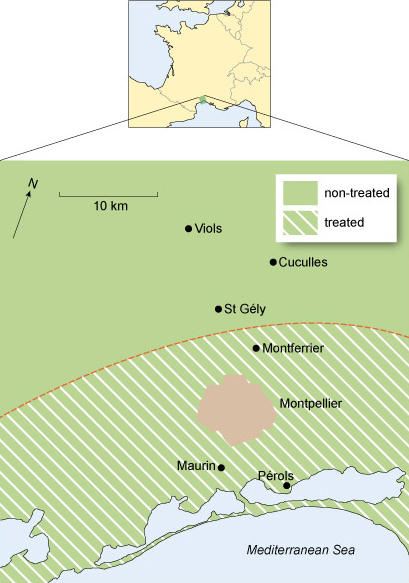1 The ester1 allele
In the 1960s, the French government attempted to rid its Mediterranean coast of mosquitoes (Culex pipiens) in order to attract tourists. It did this by regularly spraying the mosquito breeding sites located along the coast (Figure 1) with organophosphate insecticides that kill the mosquitoes by inhibiting an enzyme called acetylcholinesterase in the nervous system. The treatment was successful initially but, by 1972, the mosquito populations had begun to recover (Raymond et al., 1998).

To understand the reason for this recovery, the responses of different mosquito populations to exposure to the insecticide were examined. Researchers collected mosquito larvae from populations near the coast, where they had been sprayed with insecticide, and from populations north of the spray area, which had never been exposed to insecticide. They exposed both samples to the insecticide. In populations near the coast, which were sprayed regularly, mosquitoes were able to withstand and survive quite strong doses of the insecticide, but individuals taken from populations just north of the spraying area died when exposed to only weak doses.
Further research showed that the reason for the resistance in the coastal populations was a mutation at a locus called ester that encodes an esterase enzyme (called A1). The A1 esterase breaks down a wide range of toxins, including organophosphates. Mosquitoes that are vulnerable to the insecticide (and do not have the mutation) do not produce enough esterase to hydrolyse and thus inactivate the toxin. However, in resistant mosquitoes the mutated allele (called ester1) alters the expression of ester by gene amplification (i.e. several copies of the same gene are found in the same genome). This causes increased production of the A1 esterase and, as a consequence, resistance to the toxin.
Scientists monitored the frequency of the ester1 allele in populations at and near the coast for several years.

Activity 1
In which populations was the ester1 allele most common in each of the years shown?
Answer
In all three years, the ester1 allele frequency was highest in the populations closest to the coast.
Activity 2
Describe how the ester1 allele frequency changes with distance from the coast.
Answer
In all three years, the ester1 allele frequency declined sharply with distance inland. In 1973 the allele was not present in the mosquito populations that were furthest inland, but by 1975 and in 1978 it was detected in all populations, albeit at a much lower level in the inland populations.
Activity 3
What was the ester1 allele frequency in populations at the coast in 1973?
Answer
In 1973 the frequency of the ester1 allele was over 0.6 in populations at the coast.
Activity 4
Did the ester1 allele reach fixation in any of the populations?
Answer
Yes, it reached fixation in the populations at the coast by 1975 (an allele frequency of 1.0 indicates fixation).
Activity 5
What was the frequency of the ester1 allele in the furthest inland mosquito populations by 1978?
Answer
Approximately 0.2.
In areas where mosquitoes were sprayed, ester1 conferred a higher fitness on individuals carrying it, and these individuals passed the mutation on to their offspring. This resistance also spread to areas away from the coast (probably carried by mosquitoes migrating inland); however, as seen in Figure 2, it never reached a high frequency in inland populations. The reason for this is that the ester1 mutation carries a fitness cost to mosquitoes carrying it. The overproduction of the A1 esterase has a side effect of interfering with cholinergic synapses of the central nervous system (those in which the neurotransmitter is acetylcholine). As a result, mosquitoes carrying the allele have a high susceptibility to predation and males have low reproductive success.
A mutation that has more than one effect on an organism – such as that which gave rise to the ester1 allele – is said to exert a pleiotropic effect on the organism. In the case of the ester1 allele, where the allele has opposing effects on fitness depending on the context, the effect is known as antagonistic pleiotropy.
So why did the ester1 allele increase in coastal populations despite it increasing the likelihood of predation and lowering reproductive success? The reason is that the selection coefficient of a particular allele depends on the net effect of that allele on an organism’s fitness. In the case of the mosquitoes, the fitness gains of resistance were greater than the losses due to predation (or other fitness deficits), but only in coastal regions where the mosquitoes were sprayed. Further inland, the ester1 allele conferred no benefit because mosquitoes were not sprayed there. In these populations the ester1 allele was disadvantageous because it raised the probability of predation and/or decreased reproductive success.
